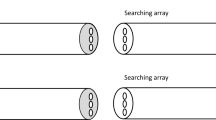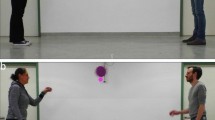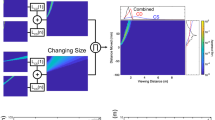Abstract
Animals use several strategies for depth vision, reflecting the constraints imposed by body size, the structure of the visual system and the visual geometry of the environment1. Arthropods in particular have restricted depth perception, because they are small and possess closely set, low-resolution compound eyes. Yet, here we show that fiddler crabs defending their burrows from conspecifics can judge how close other crabs are to their burrow. When confronted with small dummy crabs, the burrow owners assess the dummy's position and motion relative to their burrow and not relative to themselves—in other words, by using an allocentric rather than an egocentric frame of reference. Irrespective of their own distance from the dummy, the likelihood that the crabs rush back to defend their burrow increases strongly as the dummy approaches the burrow. In addition, the mean dummy–burrow distance at which the crabs respond is constant and independent of the dummy's direction of approach. We propose that to solve this sophisticated task of relative distance judgement, the crabs combine visual information on dummy position and direction with information on burrow location acquired during path integration2. In doing so, the crabs, like humans3, make clever use of the visual geometry of their environment.
This is a preview of subscription content, access via your institution
Access options
Subscribe to this journal
Receive 51 print issues and online access
$199.00 per year
only $3.90 per issue
Buy this article
- Purchase on Springer Link
- Instant access to full article PDF
Prices may be subject to local taxes which are calculated during checkout





Similar content being viewed by others
References
Collett, T. S. & Harkness, L. I. K. Analysis of Visual behaviour (eds Ingle, D. J., Goodale, M. A. & Mansfield, R. J. W.) 111–176 (MIT Press, Cambridge, MA, 1982)
Zeil, J. Homing in fiddler crabs (Uca lactea annulipes and Uca vomeris, Ocypodidae). J. Comp. Physiol. A 183, 367–377 (1998)
Ooi, T. L., Wu, B. & He, Z. J. J. Distance determined by the angular declination below the horizon. Nature 414, 197–200 (2001)
Crane, J. Fiddler Crabs of the World (Ocypodidae: genus Uca) (Princeton Univ. Press, Princeton, NJ, 1975)
Hyatt, G. W. & Salmon, M. Combat in the fiddler crabs Uca pugilator and U. pugnax: a quantitative analysis. Behaviour 65, 182–211 (1978)
Jennions, M. D. & Backwell, P. R. Y. Residency and size affect fight duration and outcome in the fiddler crab Uca annulipes. Biol. J. Linn. Soc. 57, 293–306 (1996)
Montaque, C. L. A natural history of temperate western Atlantic fiddler crabs (Genus Uca) with reference to their impact on the salt marsh. Contrib. Mar. Sci. 23, 25–55 (1980)
Zeil, J. & Layne, J. Crustacean Experimental Systems in Neurobiology (ed. Wiese, K.) 227–247 (Springer, Heidelberg, 2002)
Zeil, J., Nalbach, G. & Nalbach, H.-O. Eyes, eye stalks, and the visual world of semi-terrestrial crabs. J. Comp. Physiol. A 159, 801–811 (1986)
Krapp, H. G., Hengstenberg, B. & Hengstenberg, R. Dendritic structure and receptive-field organization of optic flow processing interneurons in the fly. J. Neurophysiol. 79, 1902–1917 (1998)
Wehner, R. ‘Matched filters’—neural models of the external world. J. Comp. Physiol. A 161, 511–531 (1987)
Schall, R. Estimation in generalized linear models with random effects. Biometrika 78, 719–727 (1991)
Zeil, J. & Al-Mutairi, M. M. The variation of resolution and of ommatidial dimensions in the eyes of the fiddler crab Uca lactea annulipes (Ocypodidae, Brachyura, Decapoda). J. Exp. Biol. 199, 1569–1577 (1996)
Land, M. & Layne, J. The visual control of behaviour in fiddler crabs I. Resolution, thresholds and the role of the horizon. J. Comp. Physiol. A 177, 81–90 (1995)
Acknowledgements
We thank P. Dixon, L. Trott and L. Howlett for help; J. Wood for advice; and M. R. Ibbotson and M. V. Srinivasan for comments on the manuscript. The work was supported by a postdoctoral fellowship from the Swiss National Foundation to J.M.H. and in part by an Human Frontier Science Program (HFSP) grant.
Author information
Authors and Affiliations
Corresponding author
Ethics declarations
Competing interests
The authors declare that they have no competing financial interests.
Rights and permissions
About this article
Cite this article
Hemmi, J., Zeil, J. Robust judgement of inter-object distance by an arthropod. Nature 421, 160–163 (2003). https://doi.org/10.1038/nature01247
Received:
Accepted:
Issue Date:
DOI: https://doi.org/10.1038/nature01247
This article is cited by
-
Views from ‘crabworld’: the spatial distribution of light in a tropical mudflat
Journal of Comparative Physiology A (2023)
-
Path integration, views, search, and matched filters: the contributions of Rüdiger Wehner to the study of orientation and navigation
Journal of Comparative Physiology A (2015)
-
Neuronal correlates of the visually elicited escape response of the crab Chasmagnathus upon seasonal variations, stimuli changes and perceptual alterations
Journal of Comparative Physiology A (2008)
-
Differences in context and function of two distinct waving displays in the fiddler crab, Uca perplexa (Decapoda: Ocypodidae)
Behavioral Ecology and Sociobiology (2007)
-
The visual ecology of fiddler crabs
Journal of Comparative Physiology A (2006)
Comments
By submitting a comment you agree to abide by our Terms and Community Guidelines. If you find something abusive or that does not comply with our terms or guidelines please flag it as inappropriate.



